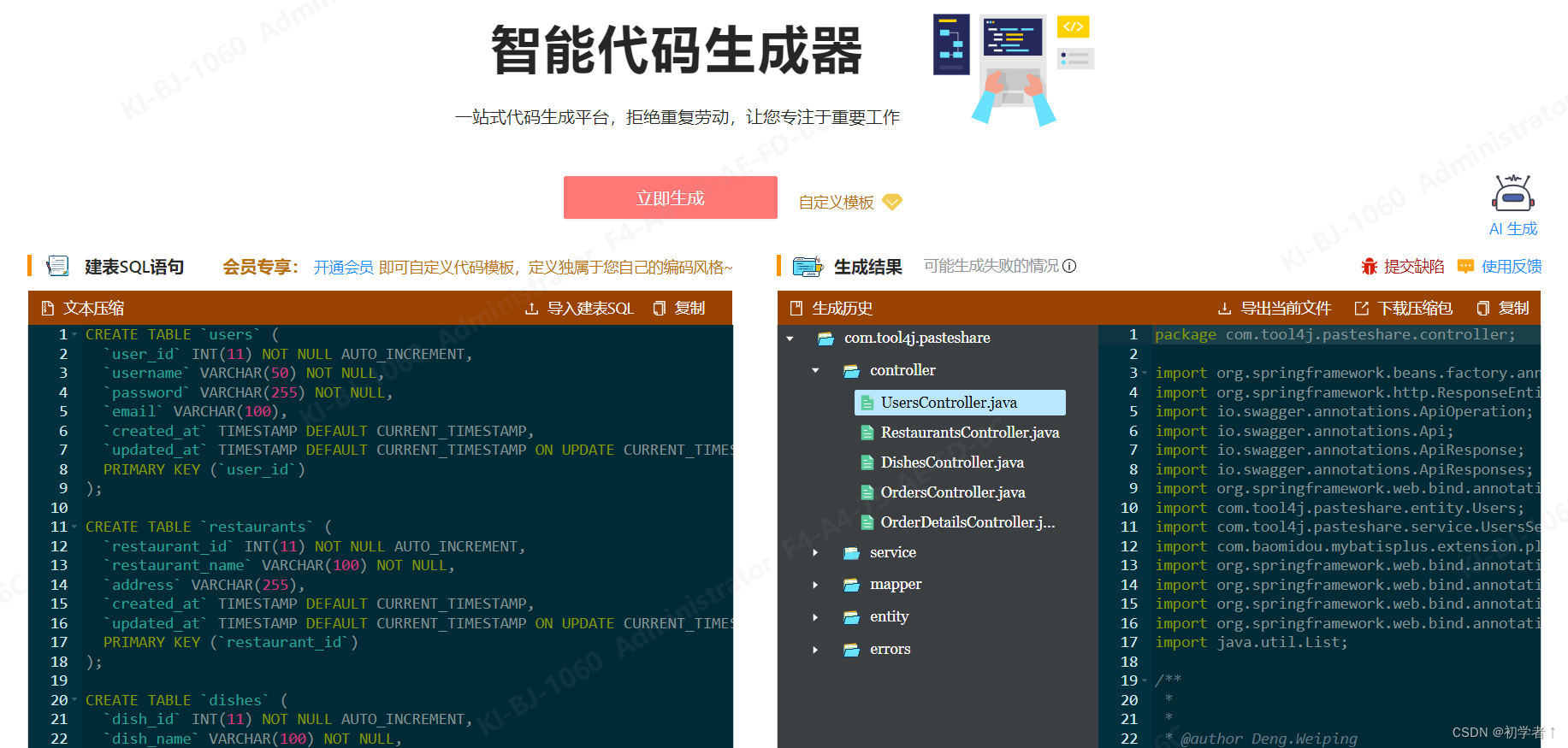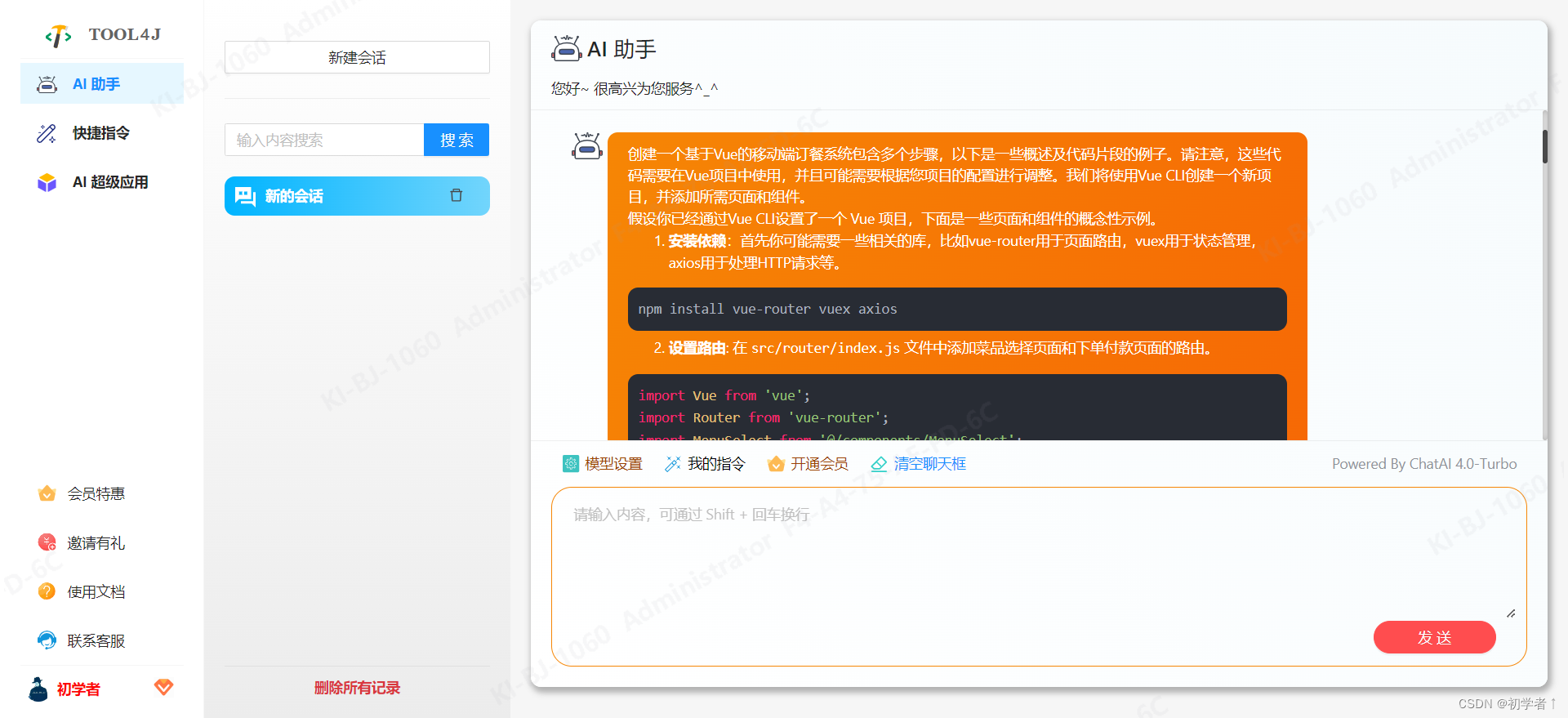AI能否真的取代程序员?
一个Java程序员从接到需求到最终开发完功能的流程大致如下
- 首先是理解原型图,设计表结构
- 根据表结构编写增删改查代码
- 与前端联调,完成功能开发
那么以上步骤AI能不能完成呢?
让我们试一下:
第一步,使用 AI助手 解析流程图,并帮我们设计出表结构
这是我找的一张原型图:

AI解析并返回的内容如下:
根据您提供的信息,我们可以设计以下表结构:
用户表 (users)
user_id (主键)
username
password (加密后的密码)
email
创建时间 (created_at)
更新时间 (updated_at)
餐厅表 (restaurants)
restaurant_id (主键)
restaurant_name
address
创建时间 (created_at)
更新时间 (updated_at)
菜品表 (dishes)
dish_id (主键)
dish_name
price
description
创建时间 (created_at)
更新时间 (updated_at)
订单表 (orders)
order_id (主键)
user_id (外键,关联到用户表)
restaurant_id (外键,关联到餐厅表)
order_status (状态,例如:待处理、进行中、已完成等)
创建时间 (created_at)
更新时间 (updated_at)
订单明细表 (order_details)
detail_id (主键)
order_id (外键,关联到订单表)
dish_id (外键,关联到菜品表)
quantity (数量)
subtotal_price (子总价)
创建时间 (created_at)
更新时间 (updated_at)
评论表 (comments)
comment_id (主键)
user_id (外键,关联到用户表)
order_id (外键,关联到订单表)
content (评论内容)
创建时间 (created_at)
更新时间 (updated_at)
以下是您所需的建表SQL语句:
CREATE TABLE `users` (
`user_id` INT(11) NOT NULL AUTO_INCREMENT,
`username` VARCHAR(50) NOT NULL,
`password` VARCHAR(255) NOT NULL,
`email` VARCHAR(100),
`created_at` TIMESTAMP DEFAULT CURRENT_TIMESTAMP,
`updated_at` TIMESTAMP DEFAULT CURRENT_TIMESTAMP ON UPDATE CURRENT_TIMESTAMP,
PRIMARY KEY (`user_id`)
);
CREATE TABLE `restaurants` (
`restaurant_id` INT(11) NOT NULL AUTO_INCREMENT,
`restaurant_name` VARCHAR(100) NOT NULL,
`address` VARCHAR(255),
`created_at` TIMESTAMP DEFAULT CURRENT_TIMESTAMP,
`updated_at` TIMESTAMP DEFAULT CURRENT_TIMESTAMP ON UPDATE CURRENT_TIMESTAMP,
PRIMARY KEY (`restaurant_id`)
);
CREATE TABLE `dishes` (
`dish_id` INT(11) NOT NULL AUTO_INCREMENT,
`dish_name` VARCHAR(100) NOT NULL,
`price` DECIMAL(10, 2) NOT NULL,
`description` TEXT,
`created_at` TIMESTAMP DEFAULT CURRENT_TIMESTAMP,
`updated_at` TIMESTAMP DEFAULT CURRENT_TIMESTAMP ON UPDATE CURRENT_TIMESTAMP,
PRIMARY KEY (`dish_id`)
);
CREATE TABLE `orders` (
`order_id` INT(11) NOT NULL AUTO_INCREMENT,
`user_id` INT(11),
`restaurant_id` INT(11),
`order_status` VARCHAR(50),
`created_at` TIMESTAMP DEFAULT CURRENT_TIMESTAMP,
`updated_at` TIMESTAMP DEFAULT CURRENT_TIMESTAMP ON UPDATE CURRENT_TIMESTAMP,
FOREIGN KEY (`user_id`) REFERENCES `users`(`user_id`),
FOREIGN KEY (`restaurant_id`) REFERENCES `restaurants`(`restaurant_id`),
PRIMARY KEY (`order_id`)
);
CREATE TABLE `order_details` (
`detail_id` INT(11) NOT NULL AUTO_INCREMENT,
`order_id` INT(11),
`dish_id` INT(11),
`quantity` INT(4) NOT NULL,
`subtotal_price` DECIMAL(10, 2) NOT NULL,
`created_at` TIMESTAMP DEFAULT CURRENT_TIMESTAMP,
`updated_at` TIMESTAMP DEFAULT CURRENT_TIMESTAMP ON UPDATE CURRENT_TIMESTAMP,
FOREIGN KEY (`order_id`) REFERENCES `orders`(`order_id`),
FOREIGN KEY (`dish_id`) REFERENCES `dishes`(`dish_id`),
PRIMARY KEY (`detail_id`)
);
CREATE TABLE `comments` (
`comment_id` INT(11) NOT NULL AUTO_INCREMENT,
`user_id` INT(11),
`order_id` INT(11),
`content` TEXT NOT NULL,
`created_at` TIMESTAMP DEFAULT CURRENT_TIMESTAMP,
`updated_at` TIMESTAMP DEFAULT CURRENT_TIMESTAMP ON UPDATE CURRENT_TIMESTAMP,
FOREIGN KEY (`user_id`) REFERENCES `users`(`user_id`),
FOREIGN KEY (`order_id`) REFERENCES `orders(`order_id`),
PRIMARY KEY (`comment_id`)
);
拿到sql语句之后,我们可以通过Tool4j在线代码生成器来生成增删改查代码

至此后端相关表的增删改查代码就已经生成结束了,当然我们还可以用 在线AI助手 基于4.0模型来生成前端代码。
以下是AI返回的内容:

完整内容:
创建一个基于Vue的移动端订餐系统包含多个步骤,以下是一些概述及代码片段的例子。请注意,这些代码需要在Vue项目中使用,并且可能需要根据您项目的配置进行调整。我们将使用Vue CLI创建一个新项目,并添加所需页面和组件。
假设你已经通过Vue CLI设置了一个 Vue 项目,下面是一些页面和组件的概念性示例。
- 安装依赖:首先你可能需要一些相关的库,比如vue-router用于页面路由,vuex用于状态管理,axios用于处理HTTP请求等。
npm install vue-router vuex axios
- 设置路由: 在
src/router/index.js文件中添加菜品选择页面和下单付款页面的路由。
import Vue from 'vue';
import Router from 'vue-router';
import MenuSelect from '@/components/MenuSelect';
import OrderPayment from '@/components/OrderPayment';
Vue.use(Router);
export default new Router({
routes: [
{
path: '/menu',
name: 'MenuSelect',
component: MenuSelect
},
{
path: '/order',
name: 'OrderPayment',
component: OrderPayment
}
]
});
- 创建菜品选择组件: 在
src/components/MenuSelect.vue创建菜品选择页面。
<template>
<div class="menu-select">
<h1>选取您的菜品</h1>
<ul>
<li v-for="item in menuItems" :key="item.id">
<div>{{ item.name }} - {{ item.price }}</div>
<button @click="addToCart(item)">添加</button>
</li>
</ul>
<router-link to="/order">下单</router-link>
</div>
</template>
<script>
export default {
name: 'MenuSelect',
data() {
return {
menuItems: [
// 假设菜单数据
{ id: 1, name: '宫保鸡丁', price: 38 },
{ id: 2, name: '鱼香肉丝', price: 32 },
// 更多菜品...
]
};
},
methods: {
addToCart(item) {
// 添加到购物车逻辑
this.$store.commit('addToCart', item);
}
}
};
</script>
- 创建下单付款组件: 在
src/components/OrderPayment.vue创建下单付款页面。
<template>
<div class="order-payment">
<h1>订单支付</h1>
<div v-for="item in cart" :key="item.id">
<div>{{ item.name }} - {{ item.price }} x {{ item.quantity }}</div>
</div>
<div>总计:{{ totalPrice }}</div>
<button @click="pay">支付</button>
</div>
</template>
<script>
export default {
name: 'OrderPayment',
computed: {
cart() {
// 这里是从 Vuex 获取购物车内容
return this.$store.state.cart;
},
totalPrice() {
// 计算总价
return this.cart.reduce((acc, item) => acc + item.price * item.quantity, 0);
}
},
methods: {
pay() {
// 模拟支付逻辑
alert('支付成功!');
}
}
};
</script>
- 设置Vuex状态管理: 在
src/store/index.js文件中,你需要设置购物车的状态管理。
import Vue from 'vue';
import Vuex from 'vuex';
Vue.use(Vuex);
export default new Vuex.Store({
state: {
cart: []
},
mutations: {
addToCart(state, item) {
// 添加到购物车逻辑,实际情况可能更复杂
const cartItem = state.cart.find(i => i.id === item.id);
if (cartItem) {
cartItem.quantity++;
} else {
state.cart.push({ ...item, quantity: 1 });
}
}
}
});
- 样式: 根据需要添加样式到各个组件。
请注意,以上代码非常基础且理论性的,在实际项目中,你需要添加更多的特性和细节,例如表单验证、支付集成、用户鉴权、响应性设计、状态管理的细分和模块化、API调用等。此外,你也需要考虑前后端数据交互和错误处理。
=========================================================
综上,我们可以看到,结合【Tool4j在线工具】,AI确实能够在很大程度上减轻我们的工作,但是暂时AI还没有完全替代程序员的能力,但是再过十年呢?
本文来自互联网用户投稿,该文观点仅代表作者本人,不代表本站立场。本站仅提供信息存储空间服务,不拥有所有权,不承担相关法律责任。 如若内容造成侵权/违法违规/事实不符,请联系我的编程经验分享网邮箱:chenni525@qq.com进行投诉反馈,一经查实,立即删除!